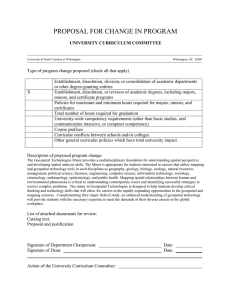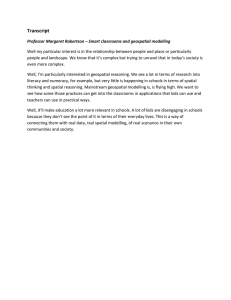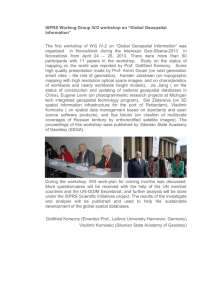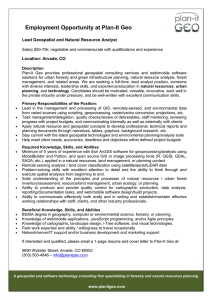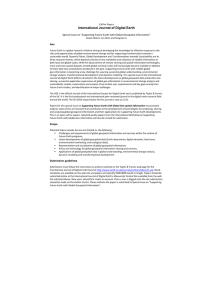Global Geospatial Information Management
advertisement
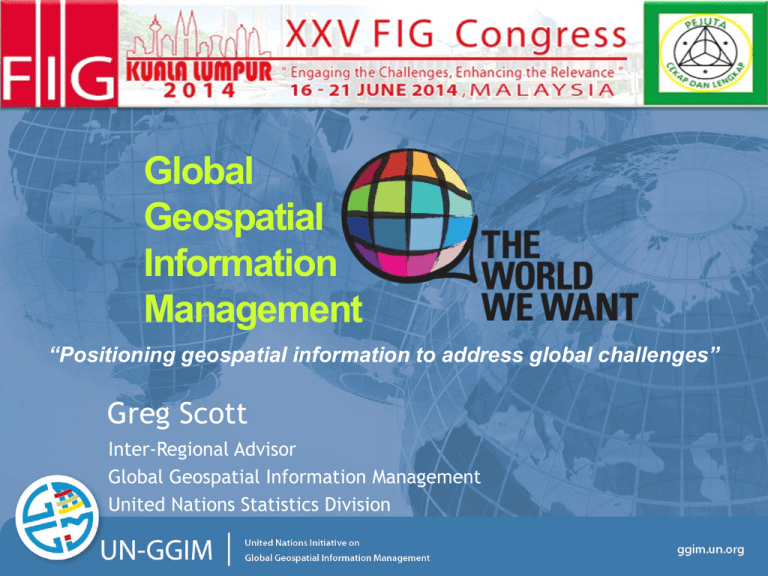
Global Geospatial Information Management “Positioning geospatial information to address global challenges” Greg Scott Inter-Regional Advisor Global Geospatial Information Management United Nations Statistics Division Positioning geospatial information to address global challenges ggim.un.org Measuring and monitoring sustainable development… Engaging the Challenges Enhancing the Relevance with geography, place, and location Positioning geospatial information to address global challenges ggim.un.org The World We Want • Ensure that globalization becomes a positive force for all the worlds’ peoples of present and future generations. • Radical shift towards more sustainable patterns of consumption, production, and resource use. • Transformative change is needed - business as usual is not an option. • There are no blueprints and one size does not fit all. • Should be a truly global agenda with shared responsibilities for all countries. http://www.un.org/en/development/desa/policy/untaskteam_undf/report.shtml Positioning geospatial information to address global challenges ggim.un.org Integrative Framework: Principles, Dimensions and Enablers Enablers: Fair and stable global trading system. Adequate financing for development and stable financial system. Affordable access to technology and knowledge. Providing sustainable energy for all. Coherent macroeconomic and development policies supportive of inclusive and green growth. Inclusive economic development Eradication of income poverty and hunger Reduction of inequalities Environmental sustainability Protection of biodiversity Stable climate Resilience to natural hazards Human rights Equality Sustainability Decent work and productive employment Enablers: Sustainable food and nutrition security. Universal access to quality health care. Universal access to quality education. Inclusive social protection systems. Managing demographic dynamics. Regulating international migration. Inclusive social development Adequate nutrition for all Quality education for all Reduced mortality and morbidity Gender equality Universal access to clean water and sanitation Enablers: Sustainable use of natural resources (climate, oceans, biodiversity) and management of waste. Managing disaster risk and improving disaster response. Peace and human security Freedom from violence, conflict and abuse Conflict-free access to natural resources Enablers: Democratic and coherent global governance mechanisms. Good governance practices based on the rule of law. Conflict prevention and mediation. Human rights protection. Women’s empowerment. A process of many voices and ideas: www.worldwewant2015.org Food security and nutrition Growth and employment Economic inequalities Population dynamics Environment Conflict & fragility Youth Governance Health LGBTI rights Indigenous peoples Water Violence against women Positioning geospatial information to address global challenges ggim.un.org Positioning geospatial information to address global challenges ggim.un.org Positioning geospatial information to address global challenges ggim.un.org How many of these focus areas capture or include elements of geography, place, and location? Positioning geospatial information to address global challenges ggim.un.org Positioning geospatial information to address global challenges ggim.un.org Positioning geospatial information to address global challenges ggim.un.org Positioning geospatial information to address global challenges ggim.un.org Positioning geospatial information to address global challenges ggim.un.org “We recognize the importance of spacetechnology-based data, in situ monitoring and reliable geospatial information for sustainable development policymaking, programming and project operations….” Para. 274 “We further recognize the importance of comprehensive hazard and risk assessments, and knowledge- and information-sharing, including reliable geospatial information” Para. 187 Positioning geospatial information to address global challenges ggim.un.org Environmental sustainability Protection of biodiversity Stable climate Resilience to natural hazards “Improving access to geographical information and geospatial data, and building capacities to use scientific information in areas such as climate monitoring, land use planning, water management, disaster risk reduction, health and food security, will allow for more accurate environmental and social impact assessments and more informed decision-making at all levels” Para. 79 Positioning geospatial information to address global challenges ggim.un.org “We also call for a data revolution for sustainable development, with a new international initiative to improve the quality of statistics and information available to citizens. We should actively take advantage of new technology, crowd sourcing, and improved connectivity to empower people with information on the progress towards the targets” Executive Summary “The post-2015 agenda must be relevant for urban dwellers. Cities are where the battle for sustainable development will be won or lost. The most pressing issue is not urban versus rural, but how to foster a local, geographic approach to the post-2015 agenda” Cities, Page. 17 http://report.post2015hlp.org/index.html Positioning geospatial information to address global challenges ggim.un.org Pillar 2: Science, technology and innovation (d) ) Optimal utilization of space and geospatial technologies: “This will require increasing investments and promoting human resources development in the management and deployment of space and geospatial technologies” Page 11 Enabling Implementation “INVEST IN and STRENGTHEN national statistical capacities and geospatial information systems for the collection, analysis, production and dissemination of disaggregated data to measure and evaluate policy effectiveness; and PROMOTE a culture of evidencebased decision making” Para 100 http://www.africa.undp.org/content/rba/en/home/library/reports/povertyreduction/common-african-position-on-the-post-2015-agenda.html Positioning geospatial information to address global challenges ggim.un.org Formal inter-governmental UN Committee of Experts to: Discuss, enhance and coordinate Global Geospatial Information Management activities by involving Member States at the highest level. Make joint decisions and set directions on the use of geospatial information within national and global policy frameworks. Positioning geospatial information to address global challenges ggim.un.org Monitoring Sustainable Development: Why Location Matters? ggim.un.org 7th Session of the Open Working Group on Sustainable Development Goals, 6-10 January 2014 The Role of Geospatial Information in Measuring and Monitoring the Sustainable Development Goals Disaster risk reduction, sustainable development, and global urbanization • • • The SDGs will depend on human and physical geography. In order to measure and monitor change and progress you must have access to fundamental and consistent geospatial information – geography. Not all targets will be equal and will require different means of measure. Indicators will need to be linked to the targets and be well defined, measurable over time, cost effective, and clearly and easily communicated. There will be a need to create a network of consistent global data – reliable geospatial information – to measure and monitor trends, change and progress over time in a standardized manner. http://ggim.un.org/OWG.html Positioning geospatial information to address global challenges ggim.un.org • To address sustainable urbanization in an integrated and focused way, effective and sustained land information systems are required for registration of land ownership and tenure. • This will depend on the availability of, and access to, national fundamental data themes and information that reliably depict features on, above, or below the Earth. • These core reference geographies, upon which all other information is based, may include: a geodetic control network; topography; elevation; water; transport; vegetation; human settlement; administrative boundaries; land ownership and use; and other socioeconomic and environmental data. • Concerted efforts should be made to bring the developing countries to a base level of capability and capacity with respect to these framework data themes. http://www.un.org/en/ecosoc/integration/2014/documentation.shtml Positioning geospatial information to address global challenges ggim.un.org http://www.fig.net/fiji/ “Positioning Positioning geospatial geospatial information information to to address address global global challenges” challenges ggim.un.org Positioning geospatial information to address global challenges ggim.un.org Measuring and monitoring sustainable development… Engaging the Challenges Enhancing the Relevance with geography, place, and location Positioning geospatial information to address global challenges ggim.un.org How do we influence and transform the agenda? “Positioning Positioning geospatial geospatial information information to to address address global global challenges” challenges ggim.un.org Our 3 pillars of potential influence Science and Technology Measure, Model and Monitor Data integration Provide the evidence Innovation, Tools and Outcomes Policy Framework Sustainable Development Local to global issues Social Economic Environmental Political awareness People Cities Livelihoods Ecosystems Development Evidence based policy Inter-governmental Decision making Influence How do we influence and transform the policy agenda? • The level of geospatial understanding and rate of uptake at the policy level is inadequate. GI needs to be moved up the value chain. • We need to engage at a much higher level, more strategically, and we need to change our language and messages in doing so. • Transformative change is needed - business as usual is no longer an option. We can no longer operate in silos. We need to find common ground and talk to each other. Challenges Change Cooperate Collaborate Commit Coherence Conquer • Consumers now innovate and drive the technology, not us. Others are providing more timely, faster, cheaper data/services. What is our niche? • We need to be global geo-information champions to remain relevant! Positioning geospatial information to address global challenges ggim.un.org How do we influence and transform the geospatial agenda? • The paradigm of data availability is changing – more real time. What is surveying and mapping for the 21st century? Innovate • We need to see geospatial data for its ‘information value’, not where it has come from or who owns it. Treat location as the basic unit. Data is going to be the key! Integrate • Data is being collected differently. No longer just for mapping and delivery, but integration, analytics, modelling, Influence aggregation and fusion. • The NSDI is more important than ever, BUT it must be viewed in a different manner. It can provide the means to Institutionalize “organize” and deliver core geographies from everywhere. • A global challenge: Spatial Data Integration, Fusion and Immediately Policy (SDIFP) platforms will provide the world’s first Global Geographic Census of Data by 2020. Positioning geospatial information to address global challenges ggim.un.org Chengdu Forum on GGIM, China, October 2013 “Development and Applications in Urban Hazard Mapping” “Geospatial information needs to contribute much more to the post2015 sustainable development agenda: disaster risk reduction; sustainable development; and the global trend towards urbanization. You, as a global professional community, must decide and determine if and how this will happen” Wu Hongbo Under-Secretary-General for Economic and Social Affairs Positioning geospatial information to address global challenges ggim.un.org Thank You Terima Kasih Positioning geospatial information to address global challenges ggim.un.org

